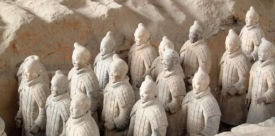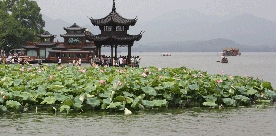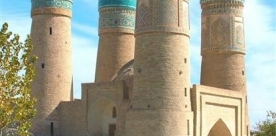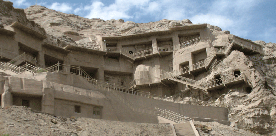Ethnic People of South Central China

Click to Enlarge
Duration: 10 Days
Trip Grade: 
In this 10 Days South Central China Tour discover colorful Yunnan, where the diversity and unique cultural heritage will never cease to amaze you. Meet and interact with ethnic minority people. Visit Kunming, Dali, Lijiang and Shangri-La.
Arrival Kunming
Arrive in Kunming, the start of this tour. Be met at the airport and transferred to your hotel for a good rest.
Overnight in Kunming
Depart from your hotel in the morning, you will take a visit to the Stone Forest, created by ancient winds and water erosion over millions of years. After the tour, you will be driven back to Kunming.
Overnight in Kunming
Stone Forest is a notable set of karst formations in Shilin Yi Autonomous County, approximately 85km from Kunming. The tall rocks seem to emanate from the ground in the manner of stalagmites, with many looking like trees made of stone, creating the illusion of a forest of stone. It has been known since the Ming Dynasty as the first wonder of the World. Approximately 270 million years ago this region was a vast ocean. Over time, the waters retreated and the limestone landscape was left. Due to a process of weathering and erosion, nature has created an art gallery of stone sculpture- present-day Stone Forest. The magnificent, strange and steep landscape creates labyrinthine vistas around each corner. Each formation has a story about animals or people associated with it.
Day 3
Flight Kunming - Dali
In the morning, you will be transferred to the airport for a short flight to Dali, the ancient political, economic and cultural center of Yunnan area. Upon arrival, visit Dali Ancient Town and Three Pagodas, the symbol of the history of Dali.
Meals: Breakfast, Lunch
Accommodation: In Dali
Dali is located on a fertile plateau between the Cangshan Mountains to the West and Erhai Lake to the East. It has traditionally been settled by the Bai and Yi minorities. Dali is the ancient capital of both the Bai kingdom Nanzhao, which flourished in the area during the 8th and 9th centuries.
Dali Ancient City is 13km (8 miles) away from Dali City. The city's history can be traced back to the early Ming Dynasty (1368-1644). According to ancient literature, the City was a gateway to the ancient Silk Road in Southwestern China. Because of its history and wealth, Dali Ancient city was surrounded by the wall which is over 6km in length, 7.5 meters high and 6 meters thick. In 1982, the northern and southern city wall towers were rebuilt to offer visitors a glimpse into the ancient wall’s grandeur. The architecture of Dali Ancient City is in the traditional Bai ethnic style and gives the city a very distinct feel. Dali Ancient City is well known for its traditional arts and crafts. It is particularly famous for its marble and hand woven handicrafts.
With a history over 1,800 years, the Three Pagodas is the symbol of Dali, and the witness of the development of Buddhism in the area. The Three Pagodas are at the East foot of the tenth peak of Cangshan Mountains and face the West shore of the Erhai Lake of the ancient Dali Town. They are an ensemble of three independent pagodas arranged on the corners of an equilateral triangle, with the main pagoda 69 meters in height. Three Pagodas together with Zhaozhou Bridge in Hebei Province and Great Wild Goose Pagoda in Xi'an are known as the three curiosities of Chinese ancient architecture.
Overnight in Dali
Today, after breakfast, you will first be transferred to the pier and take an Erhai Cruise. Then in the afternoon, you will take a leisure visit to Xizhou Bai's Houses (Yan's Courtyard included) where you can see what the Bai people's houses like.
Erhai Lake is the second largest lake in Yunnan after Dianchi Lake, and one of the seven biggest fresh water lakes in China. On sunny days, the crystal water of the lake and the snow mantled Cangshan Mountain create a beautiful scene described as silver Cangshan and jade Erhai. The surrounding isles, temples and villages of Erhai Lake are also worth visiting. The Golden Shuttle Island and the nearby fishing community of Bai people with Bai's culture and lifestyle are charming attractions. You can also enjoy the Three Courses Tea of Bai people on the isles.
You will regret it if you miss Xizhou Bai's Houses 18km north of Dali. Green mountains, winding creeks and fertile land make life here lyrical and carefree. The history of Xizhou dates back to the Sui Dynasty (581-618AD). People nowadays regard Xizhou as a town famous for the Bai culture. The old houses and streets are well preserved and visitors may still find traces of past glory. The houses of are characterized by a traditional Chinese rectangular courtyard with a screen wall facing the gate. On the screen wall usually are four Chinese characters reading 'Qingbai Shijia' (innocent family) or 'Ziqi Donglai' (Auspicious air comes from the East). Around them are landscape paintings and decorations with colors in profusion. The doors and windows are full of grills with auspicious paintings.
Day 5
Transfer by bus Dali - Lijiang
Spend about 4hours driving, you will reach Lijiang, and then take a short visit to Lijiang Ancient Town to walk down the cobblestone streets over 700 years and see the Naxi way of life which chaned little over time.
Overnight in Lijiang
Lijiang Ancient Town is well-preserved and known as a centre for the Naxi people's brilliant culture. With a history of more than 800 years, the town was built in the interval as the Song Dynasty changed to the Yuan Dynasty, and occupies an area of 3.8 square kilometers. It is built along the lie of mountains and the flow of rivers with the ancient water-supply system which is still in use today, providing a precious example for research on ancient architecture. As a result of selective adoption of ideas from other cultures by the Naxi group, the buildings in town incorporate the best of the architectural styles of Han, Bai and Tibetan, developed into the unique Naxi style. The layout of the town is free and flexible, the houses are close and diverse and the lanes are narrow and meandering. Along both sides of the lanes, there are shops selling superb handicrafts. Here you also have the chance to trace the ancient Tea-Horse Road.
In the morning drive about half an hour to visit Jade Dragon Mountain (cable car and green vans available in the scenic area). After lunch, visit Yufeng Temple and Baisha Mural in the ancient capital of Naxi Kingdom in Baisha village.
Overnight in Lijiang
Jade Dragon Snow Mountain nestles near Lijiang. It is the southernmost glacier in the Northern Hemisphere, consisting of 13 peaks with the highest one, Shanzidou, at an altitude of 5,600 meters. Looking from the town, the mountain resembles a jade dragon laying in the clouds, hence the name. The view of the massif from the gardens at the Black Dragon Pool in Lijiang is noted as one of China's finest views.
Built in 1756, Yufeng Temple is located at the southern foot of the Jade Dragon Snow Mountain, 13km from Lijiang. The temple is surrounded by a verdant forest and river with the snow mountain at its back. It displays a harmonious mix of architectural styles of Han Buddhism, Tibetan Buddhism, Taoism and local Naxi Dongba Religion. It is witness to the peaceful coexistence of multinational cultures and religions. It still plays an important role in local residents' religious life.
Baisha Mural is located at Baisha Villages, 10km north of Lijiang. Although the traditional houses do not look impressive, this was the cradle of the Naxi culture and ancient capital of the Naxi Kingdom. The valuable murals are protected inside Dabaoji Palace and the colored glaze temples. The originality and figures within the murals reflect the different religious cultures and artistic forms of Buddhism, Lamaism, Taoism and local Naxi Dongba religion's development into Naxi School. Each painting includes at least one hundred portraits, which are not only Buddha, but also ordinary people such as bureaucrats, farmers, citizens and even criminals. Many of the scenes and subjects are drawn from people's daily life showing fishing, riding horses, weaving, dancing and casting iron.
Day 7
Transfer by bus Lijiang - Shangri-la
In the morning, take another 4hours driving, the famous lost paradise Shangri-la waiting for you, a place with stunning scenery, the azure sky and the hospitality of unsophisticated people. Visit Dukezong Ancient Town upon arrival.
Overnight in Shangri-la
Shangri-la is a primarily Tibetan county in northwestern Yunnan and the capital of Diqing Tibetan Autonomous Prefecture. The county was formerly called Zhongdian but in 2001 was renamed after the fictional land of Shangri-La, from the James Hilton novel Lost Horizon. With many miles of beautiful vistas to discover, this region offers unique hiking and horse trekking opportunities to those who make the journey down to Northern Yunnan. At an altitude of 3,200 meters, Shangri-La is the start point of the Tibetan world in Northern Yunnan. The small town once was the frontier trading post on the doorstep of Tibet.
Dukezong Ancient Town, at the southeast corner of Shangri-La, offers sanctuary to all those seeking refuge from the cares of city life. Its authentic Tibetan dwellings, gilded prayer halls and pagodas, and lanterns of various shapes lighting the way along narrow, winding lanes are permeated with the grace and mystique of antiquity that enchants visitors the moment they set foot in. Dukezong means the town of moonlight in Tibetan language. With a history of over 1350 years, it has experienced both the flames of war and prosperity of frontier trade as a key stop on the Ancient Tea-Horse Trail and a focal point for Han-Tibetan exchanges.
Today, begin your exciting tour with a visit to Songzanlin Lamasery, the largest Tibetan Buddhist monastery in Yunnan, then visit Potatso National Park (green vans available in scenic area) after lunch.
Overnight in Shangri-la
Not far from Shangri-la, Songzanlin Lamasery is the largest Tibetan Buddhist lamasery in Yunnan, and one of the 13 large lamaseries in the joint area of Tibet, Yunnan and Sichuan. Constructed in 1679, it took about three years to complete. Built against the mountain with a magnificent appearance, Songzanlin is a faithful imitation of the Potala Palace in Lhasa Tibet. The most famous treasures in the lamasery are the eight gold-covered sculptures of Sakyamuni, bronze sculptures, the Ganzur scriptures hand-written in liquid gold, gold lamps, and many exquisite gilded silver incense burners.
Potaso National Park is located 22km away from Shangri-la, about half an hour's driving. As China's first national park, it mainly consists of two lakes- Shudu and Bita, the distance between takes about half an hour's driving by green van.
Day 9
Shangri-la - Kunming
In the morning you will be transferred to the airport for your flight to Kunming. Option to watch the famous Yunnan Dance show of the Peacock.
Overnight in Kunming
Day 10
Departure
Transfer to airport for departure home.
You may also like this

Glimpses of China
Duration: 8 Days
Trip Grade: 
China is home to rich and vibrant cultural tradition rooted in its historal heritage. This 8-day tour covers three ancient capitals of China: Bei...
» Read More

Naturally Hangzhou
Duration: 3 Days
Trip Grade: 
Day 1 Hangzhou
Arrive for your 3 Days Naturally Hangzhou tour, meet your guide and transfer to your Hotel of choice most preferred nea...
» Read More

Ancient Cities of China
Duration: 14 Days
Trip Grade: 
Day 1
Arrival Shanghai
Arrive in Shanghai, the bustling economic heartbeat of China, you will be met at the airport and transferred to your hotel. Fr...
» Read More

Silk Route Highlights
Duration: 9 Days
Trip Grade: 
Day 1 Fly in Urumqi and connect flight to Kashgar
Arrive in the afternoon in Kashgar, the heart of Chinese Islam, which owns the largest Muslim ...
» Read More

 UNESCO designated Jingmai Mountain Ancient Pu’er tea forests a World Heritage Site to recognize the unique tradition of growing these unique trees located in southwestern China, this cultural landscape was developed over a thousand years by the ethnic Blang and Dai peoples following…>> Read More
UNESCO designated Jingmai Mountain Ancient Pu’er tea forests a World Heritage Site to recognize the unique tradition of growing these unique trees located in southwestern China, this cultural landscape was developed over a thousand years by the ethnic Blang and Dai peoples following…>> Read More Tang dynasty shipwreck display cultural relics from 9th-century shipwreck at the Shanghai Museum, China. With a total of 248 pieces of cultural relics mostly from the Belitung shipwreck, these can be viewed for the first time on such a large…>> Read More
Tang dynasty shipwreck display cultural relics from 9th-century shipwreck at the Shanghai Museum, China. With a total of 248 pieces of cultural relics mostly from the Belitung shipwreck, these can be viewed for the first time on such a large…>> Read More













